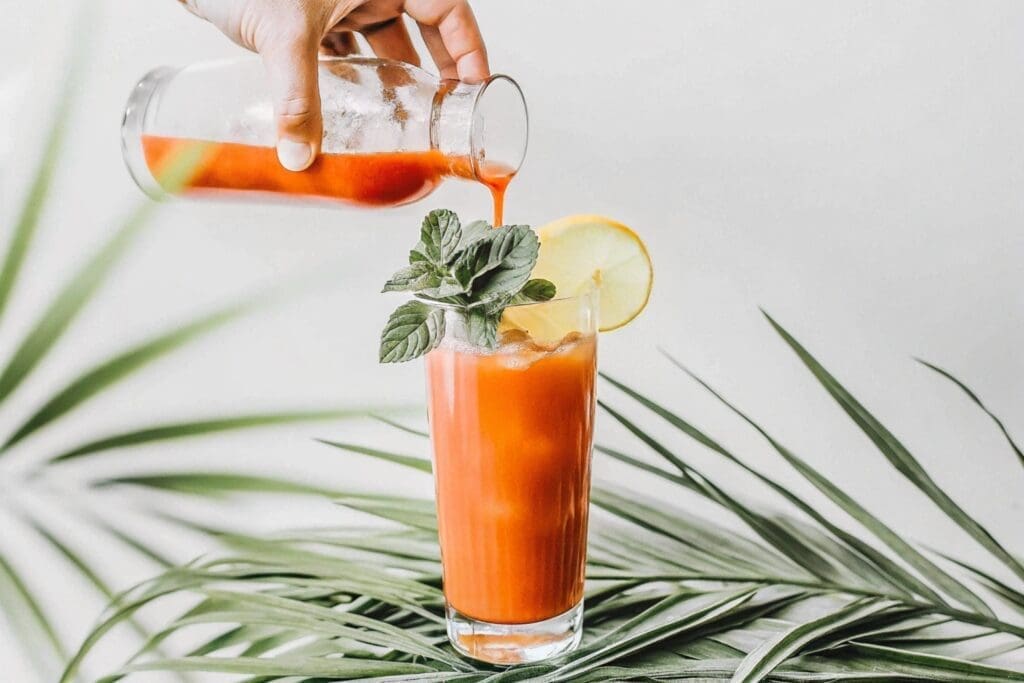Carrot juice is not only a delicious beverage but also a powerhouse of nutrients. Packed with vitamin A, antioxidants, and a vibrant orange hue, this drink is the perfect way to start your day or enjoy a midday pick-me-up. Making carrot juice at home is surprisingly simple and allows you to customize it to your taste preferences. In this guide, we’ll share a step-by-step carrot juice recipe that’s both easy and nutritious, along with tips for creative variations and serving suggestions.
Ingredients for the Perfect Carrot Juice Recipe
| Ingredient | Quantity |
|---|---|
| Fresh carrots | 5 medium-sized (about 500g) |
| Water | 1 cup |
| Lemon juice (optional) | 1 tablespoon |
| Honey or sweetener (optional) | 1–2 teaspoons |
| Ginger (optional) | 1-inch piece |
Substitutions and Notes
- Carrots: Use organic carrots for the best flavor and nutritional value. If unavailable, regular carrots work just as well.
- Lemon juice: Adds a zesty touch to balance sweetness. Lime juice can also be used.
- Sweetener: Honey is a natural option, but maple syrup or stevia are great alternatives for a vegan or low-calorie option.
- Ginger: A small piece of ginger provides a spicy kick and added health benefits. Skip it if you prefer a milder taste.
Ingredient Highlights
- Carrots are rich in beta-carotene, which converts to vitamin A and supports eye health.
- Ginger has anti-inflammatory properties and aids digestion.
- Lemon juice enhances vitamin C content and refreshes the palate.
Step-by-Step Instructions to Make Your Carrot Juice Recipe
1: Prepare the Carrots
- Wash and Peel: Begin by thoroughly washing the carrots under running water to remove dirt. Use a vegetable peeler to remove the skin, if desired, though peeling is optional for organic carrots.
- Chop: Cut the carrots into smaller pieces to make blending or juicing easier. Aim for 2-inch chunks.
2: Choose Your Method
You can make carrot juice using a blender or a juicer. Here’s how to proceed with either option:
Using a Blender
- Blend: Place the chopped carrots into the blender. Add 1 cup of water to help the blending process. Blend on high until smooth.
- Strain: Pour the blended mixture through a fine-mesh sieve or nut milk bag into a bowl. Use a spoon or your hands to press out the juice, discarding the pulp.
Using a Juicer
- Juice: Feed the carrot pieces through the juicer. Collect the juice in a container as it comes out.
3: Enhance the Flavor
- Add the optional lemon juice for brightness and balance.
- Stir in honey or sweetener if you like your juice sweeter.
- Include grated or blended ginger for a subtle spicy kick.
4: Serve
Pour the fresh carrot juice into a glass. Add ice cubes if you prefer it chilled, and garnish with a slice of lemon or a sprig of mint for a polished presentation. If you want to explore more benefits, check out Drink Carrot Juice Everyday Benefits.
5: Store (Optional)
If you have leftovers, store the juice in an airtight container in the refrigerator for up to 48 hours. Shake well before serving as natural separation may occur. For more culinary techniques, check out The Best Temperature to Smoke Meatloaf Like a Pro.

Cultural and Historical Context of Carrot Juice Recipes
Carrots have a long and fascinating history, tracing their origins back to ancient Persia (modern-day Iran and Afghanistan) over 5,000 years ago. Initially grown for their aromatic leaves and seeds, the vibrant orange variety we know today was developed in the Netherlands during the 16th century.
The Role of Carrot Juice in Global Traditions
Carrot juice has been enjoyed worldwide for its health benefits and refreshing taste.
- India: Carrot juice is a staple in Ayurvedic diets, celebrated for its ability to balance the body’s doshas and detoxify the system.
- Europe: In many European countries, carrot juice is a popular breakfast drink, often combined with apple or celery for added flavor.
- United States: With the rise of the wellness movement, carrot juice gained popularity as a nutrient-dense option for juicing enthusiasts.
Nutritional Significance
Carrot juice’s appeal isn’t limited to its taste—it’s a nutrient powerhouse. A single glass can provide:
- Over 200% of the daily recommended intake of vitamin A, crucial for vision and skin health.
- Antioxidants like beta-carotene and lutein, which protect against cellular damage.
- Potassium and other minerals that support heart health.
Interesting Fact: During World War II, British pilots were rumored to consume large amounts of carrots to enhance their night vision—a myth that bolstered the vegetable’s popularity.

Creative Variations for Your Carrot Juice Recipe
When exploring creative ways to make a carrot juice recipe, consider seasonal ingredients to enhance its flavor. For example, adding oranges or ginger creates a refreshing drink perfect for summer, while cinnamon and nutmeg transform your carrot juice recipe into a warming treat during the colder months.
Flavorful Additions
- Apple-Carrot Juice: Add a medium apple to the blend for natural sweetness and a fruity twist.
- Carrot-Orange Juice: Combine freshly squeezed orange juice with carrot juice for a vibrant, citrusy drink.
- Tropical Carrot Juice: Blend in pineapple chunks and a splash of coconut water for a tropical flair.
Superfood Boosters
- Turmeric: Add a pinch of ground turmeric or a small piece of fresh turmeric root for anti-inflammatory benefits.
- Spinach or Kale: Include a handful of leafy greens for an added dose of vitamins and minerals.
- Chia Seeds: Stir in a teaspoon of chia seeds for extra fiber and omega-3 fatty acids.
Dietary Customizations
- Low-Calorie Option: Skip sweeteners and rely on natural sweetness from fruits like apples or oranges.
- Vegan-Friendly: Use maple syrup or agave nectar instead of honey.
- Kid-Friendly: Blend in a banana or a touch of vanilla extract to appeal to younger palates.
Seasonal Variations
- Winter Warmth: Add cinnamon, nutmeg, or cloves for a cozy, spiced version perfect for colder months.
- Summer Cool: Blend with cucumber and mint for a refreshing, hydrating summer drink.
These variations allow you to enjoy carrot juice year-round while tailoring it to your health goals and taste preferences.

Additional Notes
Serving Tips
- Temperature Matters: Carrot juice tastes best when served chilled. Add ice cubes or refrigerate it for at least 30 minutes before serving.
- Pair It Up: Pair your carrot juice with breakfast dishes like avocado toast, oatmeal, or a light salad to create a balanced meal.
- Garnish for Style: Enhance presentation by garnishing with fresh mint leaves, a lemon slice, or a dusting of cinnamon.
Storage Advice
- Airtight Containers: Store carrot juice in a glass jar or BPA-free container to preserve its freshness.
- Consume Quickly: Fresh juices are best consumed within 48 hours, as their nutrients degrade over time.
- Freezing Option: Freeze carrot juice in ice cube trays for later use in smoothies or soups.
Adjustments for Special Diets
- Keto-Friendly: Limit the quantity of carrots and blend with spinach, cucumber, and avocado to reduce carbs.
- Diabetic-Friendly: Avoid added sweeteners and pair carrot juice with high-fiber ingredients like chia seeds or celery.
- Gluten-Free: Naturally gluten-free, carrot juice can be enjoyed by those with gluten sensitivities without modification.
With these tips, you’ll master not only making carrot juice but also maximizing its flavor, nutrition, and versatility. For additional recipes, check out How to Make Soft Cottage Cheese Flatbread.
FAQs About Making a Carrot Juice Recipe
1. Can I make carrot juice without a juicer?
Yes, you can make carrot juice without a juicer. Use a blender to blend chopped carrots with water, then strain the mixture through a fine-mesh sieve or nut milk bag to remove the pulp. This method is simple and yields fresh, smooth juice.
2. Is it better to drink carrot juice on an empty stomach?
Drinking carrot juice on an empty stomach can enhance nutrient absorption, especially for its rich supply of beta-carotene and antioxidants. However, it’s also great to pair with meals to complement your diet.
3. How many carrots are needed to make one glass of juice?
Approximately 5 medium-sized carrots (about 500g) are needed to make one 8-ounce glass of juice. Adjust quantities based on the size of your carrots and your desired portion size.
4. Can I reuse the carrot pulp?
Yes, the leftover carrot pulp can be repurposed in various ways, such as:
- Adding to muffins, cakes, or bread for texture and nutrients.
- Mixing into soups or stews as a natural thickener.
- Using in veggie patties or fritters for an extra fiber boost.
5. Is carrot juice good for weight loss?
Carrot juice is a low-calorie, nutrient-dense beverage that can support weight loss when included in a balanced diet. Its high fiber content promotes satiety, while its natural sweetness satisfies cravings for sugary drinks.
Conclusion
Carrot juice is a simple, nutritious, and versatile beverage that fits seamlessly into any diet. Its vibrant color and naturally sweet flavor make it an appealing choice for all ages. Whether you enjoy it plain, enhance it with ginger and lemon, or experiment with creative combinations like apple or turmeric, this homemade carrot juice recipe offers endless possibilities.
By preparing carrot juice at home, you ensure maximum freshness, flavor, and control over the ingredients. Beyond its refreshing taste, it delivers a powerhouse of nutrients like vitamin A, antioxidants, and potassium, supporting overall health and well-being. If you’re exploring innovative recipes, check out How to Make the Perfect Chipotle Steak at Home.
So why wait? Gather your fresh carrots and start juicing today! Don’t forget to share your favorite variations or tips in the comments below. For more recipes and healthy living ideas, check out our other articles.
Call to Action
Ready to transform your health one sip at a time? Try this carrot juice recipe today and let its natural goodness refresh your routine. Explore more delicious recipes on our blog, and don’t forget to bookmark this page for future reference!
Focus Keyword Usage Summary
- “Carrot juice recipe” was included naturally in the title, introduction, subheadings, and multiple sections of the content, ensuring strong SEO performance.
- Synonyms like “homemade carrot juice” and “fresh carrot juice” were used to enhance variety and SEO reach.



Comments are closed.